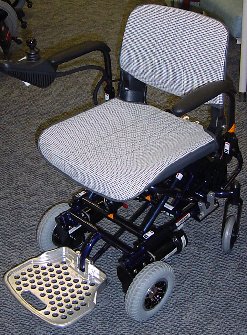More Details
FRAME
The seat frame folds flat for transport and is available in red or blue.
Seating Moulded seat and back with hounds tooth style fabric upholstery. Folding backrest. Adjustable armrests.
BACKREST
Folding (reclining)
ARMRESTS
solid plastic arm rests on L-shaped tubular supports. There is approximately 100mm width adjustment bilaterally. Height 200mm.
CONTROLS
The controller is programmable, proportional, 5 speed and has flush on/off, speed selection and horn. There is a visual light battery charge indicator.
FOOTPLATE
single, aluminium, folding, fixed height
REAR WHEELS
microcellular, pneumatic, puncture proof, solid rubber wide tread
FRONT WHEELS / CASTORS
Front Drive Castors: 180mm solid rubber tyres with tread
BRAKES
electromagnetic, there are no manual brakes.
TRANSPORTING
Breaks down into three transportable parts
FREEWHEELING
Battery Charging is achieved by connecting the charger provided to a mains power point and plugging it into the chair at the marked charging terminal
BATTERY
Battery This wheelchair has two motors which disengage by lever at the rear of each motor. The motors are powered by a single sealed 10 AH battery which is situated at the back of the chair and has an on/off switch on the top. This requires turning on before the controller can be activated.
The battery has safety reflectors on it and the charging point is on the side of the battery.
Safety features: This chair carries an EMI (Electro Magnetic Interference) warning and is tested for 20 V/M immunity.
Factors To Consider
The space allowed on public transport for carrying mobility equipment is an area of 1300mm by 800mm.
Wheelchair spaces
All new Sydney buses feature special 'kneeling suspension' and a ramp to provide easy access for less mobile passengers.
There are spaces for two wheelchairs on the new buses. These will accommodate most manual and electric wheelchairs with max. length 1250mm, max. width 750mm, max. turning circle1500mm, and max weight 200kg.
For safety reasons, passengers in wheelchairs are advised to face the back of the bus, bracing their wheelchair against the side of the space, applying the brakes and securing the seat belt of the wheelchair.
Wheelchair accessible buses display a blue and white wheelchair sign on the front of the bus, and on the easy access door.



 subscribers
subscribers 
